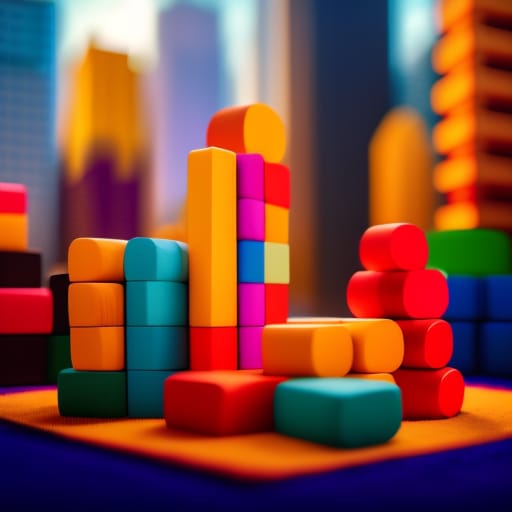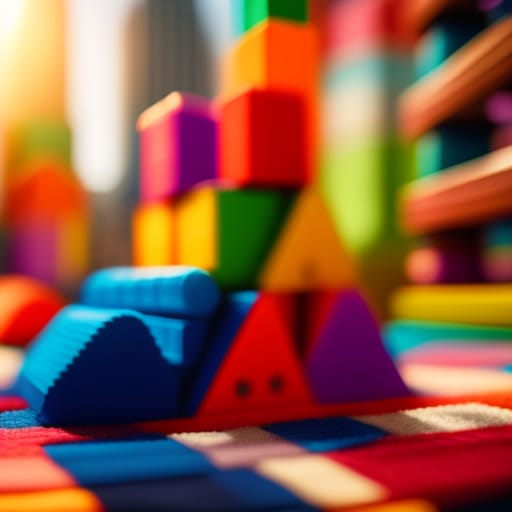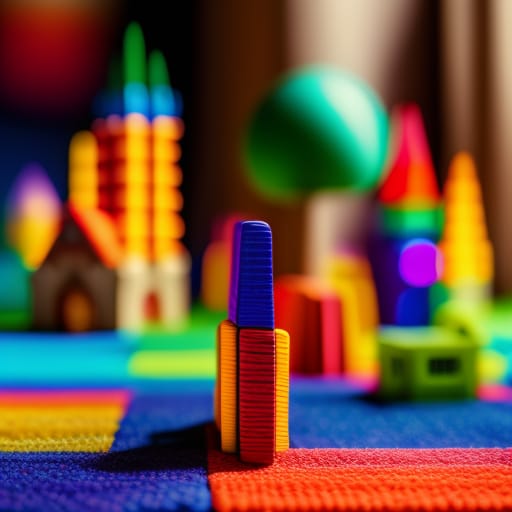Wooden toy blocks have been a beloved plaything for children for generations. These simple wooden cubes inspire creativity, develop skills, and provide endless hours of imaginative playtime. If you’re considering wooden blocks for the kids in your life, this beginner’s guide will tell you everything you need to know about their benefits, types, top brands, and more.

What Are Wooden Toy Blocks?
Wooden toy blocks are construction toys made from natural wood cut into cubes, rectangles, arches, and other geometric shapes. They are designed to be stacked, sorted, arranged, and built into creations limited only by a child’s imagination.
Wooden blocks trace their origins back to the 1830s when Friedrich Froebel, considered the inventor of kindergarten, created educational toys he called “Froebel Gifts” to demonstrate his theories of learning through play. His Second Gift featured cubes, spheres, and cylinders carved from wood.
Ever since, wooden blocks have been a staple in nurseries and classrooms around the world. No two sets of blocks are exactly alike, but their open-ended play value remains constant. Simple wooden blocks made from maple, birch, beech, and other hardwoods withstand the test of time as one of the most enduring children’s toys.
The Benefits of Playing with Wooden Blocks
Open-ended toys like wooden blocks have multiple benefits for a child’s development. Here are some of the top reasons why wooden blocks are an excellent toy choice:
Enhancing Creativity and Imagination
Wooden blocks are an open-ended toy with no prescribed use, which allows children to build and create anything they can imagine. Structured play encourages divergent thinking, problem-solving, and cognitive flexibility. Kids are motivated to constantly invent new structures and scenarios during block play.
Developing Motor Skills and Hand-Eye Coordination
The simple act of picking up, stacking, and maneuvering wooden blocks develops fine motor strength and dexterity. Eye-hand coordination is improved as kids learn to align blocks and build vertically. Gross motor skills are strengthened through reaching, stretching, and balancing blocks.
Improving Cognitive and Problem-Solving Abilities
Wooden blocks are considered construction toy, which means they help children develop STEM-related capabilities like spatial reasoning, shape recognition, and structural engineering. Kids learn concepts like balance, proportion, and cause and effect through block building.
Encouraging Social and Emotional Development
Collaborative block play promotes important social skills like sharing, cooperation, turn-taking, and verbal communication. Wooden blocks also teach lessons in persistence, creativity, and resilience when constructions topple and must be rebuilt.
Promoting Language and Communication Skills
As kids build, they learn new vocabulary words to describe shapes, colors, patterns, sizes, positions, and relationships. Block structures provoke storytelling and language-based pretend play scenarios among children.
Wooden blocks check off all the boxes for an educational toy that grows with a child. Their deceptively simple design harbors an incredible capacity for open-ended, imaginative learning through play.
Types of Wooden Blocks
Not all wooden blocks are made equal. There is a diverse range of wooden blocks featuring different qualities like shape, size, color, texture, and more. Here are some of the most common types of wooden blocks:
Basic Building Blocks
These are simple wooden cubes, rectangles, arches, and triangles in a rainbow of colors. They form the foundation of any wooden block set for a freeform building. Melissa & Doug make excellent starter sets.
Stacking Blocks
Stacking blocks have grooves or protruding nubs to allow secure vertical stacking. They often feature embedded numbers, letters, or pictures. Grimm’s makes beautiful rainbow stacking blocks.
Sorting and Shape Blocks
These wooden blocks help kids learn shapes, colors, and logical thinking through sorting activities. Each block will feature a distinct shape, color, size, or pattern. EverEarth makes great shape sorter boxes.
Pattern and Color Blocks
Pattern blocks build early math skills by illustrating concepts like fractions and symmetry. Color blocks in distinct hues teach color recognition and mixing. Plan Toys makes lovely sets for color and pattern play.
Specialty Blocks
Look for unique block shapes like curved ramps, bridges, cars, trees, and people to expand building possibilities. Community Playthings makes specialty blocks like cities, farms, and zoos.
Choosing an assortment of blocks in different styles offers the most versatility. Mix and match blocks from multiple sets for the ideal wooden block collection.
How to Choose the Best Wooden Blocks
With so many wooden block sets on the market, how do you choose quality blocks that will stand the test of toddler-powered construction? Follow this criteria when selecting the best wooden blocks:
Age-Appropriate Blocks
Select blocks suitable for the child’s developmental stage, with chunkier blocks for babies and more complex sets as kids grow. Most brands recommend age ranges.
Safe and Non-Toxic Materials
Wooden blocks should be made from untreated, unfinished wood with non-toxic stains or plant-based dyes. Solid hardwoods like maple and birch are durable yet lightweight.
Sustainable and Eco-Friendly Options
Look for FSC-certified wood from sustainable forestry sources. Avoid plastic components or finishes that could contain BPA or VOCs. Unvarnished wood is best.
Open-Ended Play Possibilities
The best wooden blocks allow for imaginative play without dictating a “right way” to build. Simple, loose blocks with minimal kitschy decorations are ideal.
Reviews and Recommendations
Consult wooden block reviews and ask for recommendations from fellow parents. Trusted brands that use quality materials will show in durability and longevity.
The most beneficial wooden blocks engage kids’ minds while letting them build freely and creatively. Remember that wooden blocks are an investment in imagination and learning that can be passed down and enjoyed for generations.
Educational Value of Wooden Blocks
Beyond just being fun, wooden blocks provide meaningful educational value that forms an integral part of many preschool teaching philosophies. Here’s an overview of the academic benefits of playing with wooden blocks:
STEM Learning Opportunities
Wooden blocks are construction toys that introduce foundational STEM concepts. Kids explore engineering, physics, spatial reasoning, design, and mathematics through block play.
Early Childhood Development Research
Studies demonstrate wooden blocks’ ability to improve skills in language, creativity, collaboration, fine motor control, problem-solving, and spatial relationships.
Montessori and Waldorf Educational Philosophies
Wooden blocks are core materials in Montessori classrooms for developing coordination and concentration. Waldorf programs use stacking blocks to teach sequencing and patterns.
Learning Through Play
Wooden blocks offer the ideal medium for active learning-by-doing during the critical developmental years from ages 1 through 6. Kids remain engaged through play.
Open-ended wooden blocks empower kids to build foundational knowledge across many disciplines. Wooden blocks also align with research on learning through play during early childhood.
Wooden Blocks for Different Age Groups
Wooden blocks provide age-appropriate developmental benefits from infancy through the elementary years. Here’s a quick look at how wooden blocks can be enjoyed by kids of all ages:
Infants and Toddlers
- Simple grasping and holding aids in fine motor development
- Mouthing and teething soothe sore gums
- Stacking and nesting introduce problem-solving skills
- Vibrant colors and pictures promote visual stimulation
Preschoolers
- Imaginative building sparks creativity
- Basic STEM concepts like shapes, balance, and patterns
- Increased hand-eye coordination and dexterity
- Early math skills like sorting, sequencing, and fractions
Elementary School Children
- Follow diagrammed instructions for complex structures
- Learn engineering and physics by building
- Improve spatial reasoning and geometric skills
- Encourage patience, resilience, and collaboration
Tweens and Teens
- Build unique sculptures, mazes, and chain reactions
- Promote creative thinking and 3D design skills
- Combine blocks with other materials for artistic projects
- Make DIY games like block bowling or tic-tac-toe
Wooden blocks provide an unmatched range of developmentally appropriate benefits for kids of all ages when selected and used properly. They are a toy with longevity that can be enjoyed from toddlerhood through adolescence.
Wooden Blocks for Special Needs Children
In addition to typical developing children, wooden blocks can also provide therapeutic benefits to children with special needs. Here are some of the ways wooden blocks can aid special needs kids:
Sensory Integration Therapy
For kids with sensory processing issues, handling wooden blocks provides calming tactile input. The blocks can be used as fidget toys or incorporated into therapy exercises.
Occupational Therapy
Stacking, sorting, and building with wooden blocks improves fine motor and visual perception skills for children in occupational therapy.
Speech and Language Therapy
Early vocabulary building happens naturally as kids discuss and describe wooden block structures. Blocks encourage language development for kids in speech therapy.
Autism Spectrum Disorder
The repetitive motions involved in stacking blocks provide comfort for some children with autism. Joint block play builds social skills.
ADHD
The hands-on activity of building wooden block structures allows kids with ADHD to channel their energy and focus their attention.
Wooden blocks are an open-ended and versatile therapy material suitable for kids with a range of exceptional needs. Consult your child’s therapist or special education teacher to explore customized wooden block activities targeting specific developmental goals.

DIY Wooden Toy Blocks
Part of the charm of wooden blocks is that they are relatively easy to make from scratch. Custom-made blocks let kids create their own toys personalized with decorations, colors, and engraved names or messages. Follow these steps for DIY wooden blocks:
Materials and Tools Needed
- 1/2 to 3/4 inch unfinished wood stock
- Wood glue
- Acrylic paint and/or wood stains
- Sandpaper
- Table saw miter saw, or handsaw
- Wood chisels for engraving
- Drill and drill bits
- Eye and ear protection
Step-by-Step Instructions
- Cut wood into cubes and rectangular prisms in desired sizes
- Sand blocks smooth and round edges for safety
- Engrave designs, letters, or symbols with a wood chisel
- Apply non-toxic stains, paints, or wood finishes and allow to dry
- Drill holes or embed magnets (supervise for safety)
- Allow kids to decorate blocks with markers, stickers, glitter, etc.
- Seal with non-toxic sealer and allow to cure before use
Customization and Personalization Options
- Paint blocks in custom colors
- Chisel kids’ names or initials
- Embed alphabet tiles, gems, or hardware
- Use fun paints like chalkboard, glow-in-the-dark, or glitter
Handmade wooden blocks make great keepsakes and gifts. Adjust block sizes and designs to suit kids of different ages. Always supervise children and explain tool safety when making DIY blocks.
Top Wooden Block Brands
With the array of wooden blocks available, it helps to stick with top trusted brands known for quality materials and imaginative designs. Here are five of the best wooden block brands:
Melissa & Doug
Melissa & Doug make an extensive range of wooden blocks including numbered building sets, alpha blocks, and patterns. Their products emphasize classic wooden play.
Hape
This German company uses eco-friendly bamboo and FSC beech wood for colorful block sets promoting sustainability. They have a unique modern style.
PlanToys
Handcrafted in Thailand, PlanToys makes innovative wooden blocks shaped like towns, zoos, orchards and more to inspire role-play. Made from rubberwood.
Grimm’s
Known for their rainbow-stacking pyramids, Grimm’s also makes beautiful wooden block sets featuring creative patterns and pictures. Based in Germany.
Tegu
Tegu block sets contain magnets allowing for unique block structures like pivoting hinges. Made from sustainably sourced Honduran hardwoods.
Look for sets by these brands when selecting wooden blocks to ensure reliable quality and safety from trusted manufacturers. Their unique block designs will spark endless creativity.
Wooden Blocks Gift Ideas
Thanks to their universal appeal, wooden blocks make a perfect gift for kids of all interests and ages. Here are some top occasions and recipients for wooden block gifts:
Birthdays
An engaging new set of blocks is a can’t-fail birthday present for toddlers through elementary schoolers. Choose blocks suiting the child’s age and interests.
Holidays
Wooden blocks in holiday themes like Christmas trees, Hanukkah dreidels or Easter eggs make ideal stocking stuffers. Or give a classic starter set year-round.
Newborns
Welcome a new baby with a sweet set of soft, colored grasping blocks or a keepsake block engraved with their name and birth stats.
Preschool or Kindergarten Graduation
Specialty blocks engraved with the year make a meaningful memento of this educational milestone.
Children’s Museums, Classes or Camps
Donate a set of wooden blocks to a children’s organization for a charitable gift that will be enjoyed by many kids.
With so many occasions to give gifts to children, wooden blocks are always appropriate. Tailor your wooden block gift by age, interests, and budget.
Caring for Wooden Blocks
Wooden blocks are designed to withstand vigorous use, but toys played with by young kids do require some basic care. Here are tips on cleaning, storing, and maintaining wooden blocks:
Cleaning and Sanitizing
- Wipe with a damp cloth and mild soap and water
- For deeper cleaning, use disinfectant wipes or sprays
- Air dry completely before storage
- Sunlight is a natural disinfectant – blocks can dry in the sun
Storage and Organization
- Store in a basket, bag, or bin out of direct sunlight
- Consider a wall-mounted display shelf to corral stray blocks
- Label bins with pictures for easy clean-up
- Check for damage and splinters before each use
Repair and Replacement
- Use wood glue to repair loose parts or broken blocks
- Replace overly damaged or missing blocks to maintain a complete set
- Consider buying extra blocks to replenish sets subjected to heavy use
- Hand-me-down blocks may need refinishing or reconditioning
With proper care, the best quality wooden blocks can be enjoyed by generations of children. Maintain your blocks well so they can inspire young imaginations for years to come.
Wooden Blocks vs. Other Building Toys
Wooden blocks have distinct advantages over other construction toys for young children. Here’s how they compare to some other options:
Plastic Blocks
Plastic block sets, like Mega Bloks, tend to have more small pieces. Plastic’s hard edges and light weight increase the chances of painful accidents. Wood has a softer feel.
Magnetic Tiles
Magnetic building tiles from brands like Magna-Tiles enable unique structures but lack wooden blocks’ durability. They also pose hazards if magnets detach and are swallowed.
LEGO
LEGO bricks inspire amazing creations but are best suited for older kids. Younger kids may still mouth and accidentally choke on small LEGO pieces. LEGO sets also have fixed building outcomes.
Lincoln Logs
These classic notched wood logs assemble into cabins and forts. But their smaller pieces and choking hazards make Lincoln Logs less ideal for toddlers than basic wooden unit blocks.
Wooden blocks made from solid wood have an exceptional safety profile, especially for infants and toddlers. They have universal appeal from babies mouthing blocks up to older kids constructing elaborate structures. Wooden blocks are hard to beat for versatility.

Wooden Blocks in Pop Culture
Beyond the playroom, wooden blocks have carved out a niche in movies, TV shows, art, and more. Here are some examples of wooden blocks in pop culture:
Famous Wooden Block Sets
- The 1891 Frobel Kindergarten block set sold at the Sears Roebuck catalog for $26.75.
- Frank Lloyd Wright’s Son’s Builder Blocks, created in the 1920s, were intricate maple and redwood blocks.
- The 1950s company Creative Playthings made mid-century modern block sets like Color Pins and Fiddle Sticks.
Block-Inspired Movies and TV
- Caillou, Charlie Brown, and Dora the Explorer all feature episodes with blockplay themes.
- Pixar’s animated short “Presto” stars a magician, his rabbit, and wooden building blocks.
- The Three Little Pigs and The Big Bad Wolf are commonly depicted in wooden block books and toys.
Wooden Block Art and Design
- Artist Rachel Ducker creates intricate mosaic portraits from thousands of wooden blocks.
- Architect Frank Gehry’s iconic buildings like the Walt Disney Concert Hall resemble stacked wooden blocks.
- Variations on abstract wooden block sculptures are popular public art pieces.
The ubiquity of wooden blocks in children’s lives has translated to their appearance as cultural symbols of youth and innocence in mainstream media. Blocks convey a sense of simplicity, nostalgia, and creativity.
Wooden Blocks Around the World
Wooden blocks are a worldwide childhood toy with examples from many cultures. Here are some international wooden block traditions:
Cultural and Traditional Wooden Blocks
- Japan – Kumiki building blocks develop spatial skills
Frequently Asked Questions about Wooden Blocks
What are the benefits of wooden blocks for my child’s development?
Wooden blocks provide many developmental benefits through open-ended play. They build skills in areas like creativity, imagination, motor skills, hand-eye coordination, problem-solving, spatial reasoning, and STEM concepts. Wooden blocks are also praised by educational philosophies like Montessori and Waldorf.
What are the best wooden block brands I should look for?
Some top wooden block brands include Melissa & Doug, Hape, PlanToys, Grimm’s, and Tegu. Look for brands that emphasize classic wooden construction toys made from natural hardwoods like maple, beech, and birch. Made in the USA, Europe or sustainably sourced woods are best.
How can I incorporate DIY wooden blocks into my child’s play?
Making your own wooden blocks is a great way to save money while creating unique keepsakes. With adult supervision, kids can help decorate and customize their own blocks. Basic materials you’ll need include wood like maple, wood glue, acrylic paints, sandpaper, a saw, and wood chisels for engraving.
What types of wooden blocks are best for my toddler?
For toddlers, chunky basic building blocks, stacking blocks, shape sorters, and blocks with bright colors are ideal. Look for blocks sized 1-2 inches across, which are easy for small hands to grasp. Toddlers also benefit from blocks with pictures or embedded letters, numbers, and symbols that aid early learning.
How can I incorporate STEM learning into wooden block playtime?
Encourage basic engineering by guiding kids to build vertically and balance blocks. Sort blocks by attributes like color, shape, or size to illustrate math concepts. Stack blocks in repeating patterns to display symmetry. Build arches and bridges to demonstrate physics concepts like gravity and tension. Let them experiment!